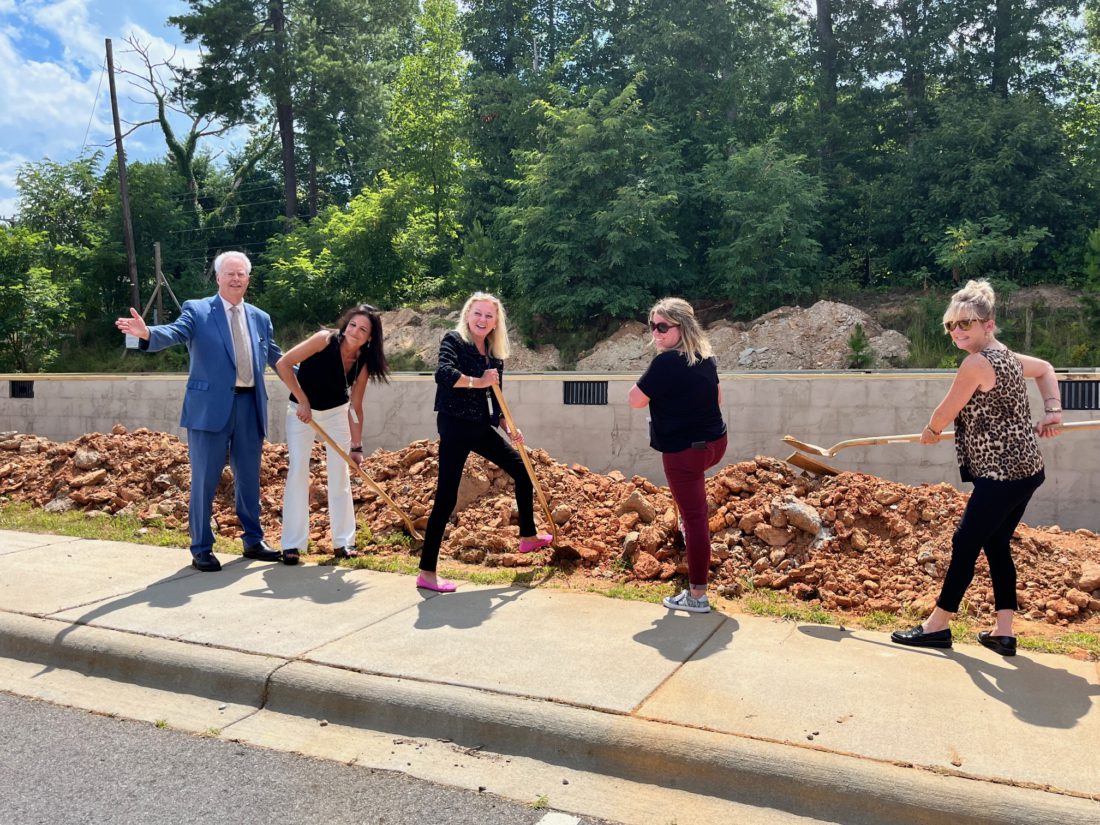Asheville Buncombe Community Christian Ministry (ABCCM) broke ground July 16 on a shelter for women and children.
Safe Haven will be an emergency shelter operating 24/7 and year-round. It will provide 36 beds for single women, women with children and up to two intact families. Safe Haven is on the same property as Transformation Village, ABBCM’s transitional housing shelter that provides beds for up to 100 women and children.
“We just want everybody to come,” ABBCM Executive Director the Rev. Scott Rogers told the crowd assembled for the groundbreaking. “Anybody can come. We don’t need ID — we’ll find out who you are as we go. We need you to be safe, and we will find out how safe you can be. We have the support of everybody to make sure it is safe for everybody.”
The estimated cost for the Safe Haven build will be $500,000, he told Xpress.
Several other emergency shelter options exist in Buncombe County, including Helpmate, which provides shelter for individuals fleeing domestic violence, Western Carolina Rescue Ministries and The Salvation Army of Asheville and Buncombe County.
What Safe Haven will provide
Transformation Village has offered transitional housing for women and youths since 2002. Safe Haven would be its first stand-alone emergency shelter, but for several years Transformation Village has provided emergency beds when Code Purple is called.
Code Purple is a communitywide program that temporarily increases shelter beds during freezing temperatures. During Code Purple, shelters waive some of their regulations, such as requiring identification.
ABCCM hopes to open Safe Haven by Oct. 15 so it is available when cold weather arrives, Rogers told Xpress.
Once completed, Safe Haven will be 3,700 square feet, comprising nine bedrooms, six bathrooms, a community room and a dining room. It will provide three meals a day, with hot meals coming from the main kitchen at Transformation Village.
Recent efforts to address homelessness locally have focused on reducing barriers to shelter, such as the inability for families to stay together in one setting. Boys and girls up to age 17 will be accepted into Safe Haven, Rogers says.
Another barrier for homeless people and people fleeing domestic violence seeking shelter is the potential separation from their pets. There won’t be a kennel on-site at Safe Haven, Rogers tells Xpress. He says that ABCCM has relationships with the Asheville Humane Society, Brother Wolf Animal Rescue and local veterinarians who can board animals.
Active substance use can be another barrier — one that can prove fatal in freezing temperatures. In a press release about Safe Haven, ABCCM states, “Persons may enter while intoxicated but may not do drugs or consume alcohol on campus and must not be a threat to others or themselves.”
In addition to Safe Haven, ABCCM has additional shelter plans in the works: a 38-unit apartment building, containing 114 beds, that will provide permanent supportive housing and a 128-bed recovery housing facility. Rogers estimates the total cost of Safe Haven and two additional facilities will be $10.5 million. It already has $6 million in pledges.
Community’s shelter plans
Safe Haven is one piece of a larger game of Tetris for the community’s plan to address homelessness.
In early 2022, Dogwood Health Trust funded a study by Washington, D.C.-based nonprofit National Alliance to End Homelessness about how Asheville and Buncombe County could reduce homelessness. Its report, which mapped a pathway to reduce homelessness by half, was presented to the community in January 2023.
NAEH recommended Asheville and Buncombe County add 95 beds to its shelter capacity permanently. Its report advised 60 beds for single adults, 25 beds with support for mental health and substance use, and 10 beds for families with children.
In an effort to address an immediate need for emergency shelter, the Homeless Initiative Advisory Committee identified three organizations that could temporarily provide 43 beds: three at Haywood Street Respite, 20 at The Salvation Army and 20 with Safe Shelter, an initiative among churches. These are temporary solutions because they have been funded for only one year, but they could be extended, says City of Asheville homeless strategy division manager Emily Ball.
The NAEH report recommended establishing a low-barrier shelter, also called a high-access shelter, that would provide emergency shelter beds more consistently. A city and county shelter planning team is identifying preferred services for a low-barrier shelter that would have 100 year-round beds with the ability to add 50 beds when needed. Ball notes that the beds could be provided at one shelter location or spread across shelters at multiple locations.
A request for proposals for the low-barrier shelter was issued July 15. Following a review of the proposals, a shelter planning work group will submit its recommendation at the Thursday, Aug. 15, meeting of the Asheville-Buncombe Continuum of Care, a planning body overseeing services to the community’s homeless population, says Ball. If approved, that proposal will head to Buncombe County for funding consideration, she says.






Before you comment
The comments section is here to provide a platform for civil dialogue on the issues we face together as a local community. Xpress is committed to offering this platform for all voices, but when the tone of the discussion gets nasty or strays off topic, we believe many people choose not to participate. Xpress editors are determined to moderate comments to ensure a constructive interchange is maintained. All comments judged not to be in keeping with the spirit of civil discourse will be removed and repeat violators will be banned. See here for our terms of service. Thank you for being part of this effort to promote respectful discussion.